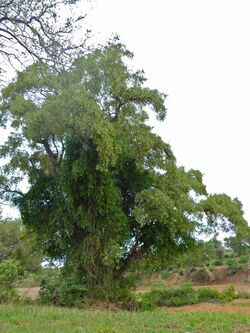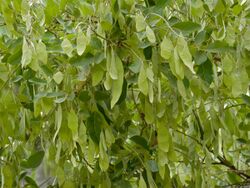Biology:Philenoptera violacea
| Philenoptera violacea | |
|---|---|

| |
| Habit | |

| |
| Fruit | |
| Scientific classification | |
| Kingdom: | Plantae |
| Clade: | Tracheophytes |
| Clade: | Angiosperms |
| Clade: | Eudicots |
| Clade: | Rosids |
| Order: | Fabales |
| Family: | Fabaceae |
| Subfamily: | Faboideae |
| Genus: | Philenoptera |
| Species: | P. violacea
|
| Binomial name | |
| Philenoptera violacea (Klotzsch) Schrire
| |
| Synonyms | |
| |
Philenoptera violacea known also as apple leaf or rain tree, Afrikaans: Appelblaar, Sotho: Mphata, Tsonga: Mohata, Zulu: Isihomohomo, IsiNdebele: Ichithamuzi, Idungamuzi, Iphanda) is a plant species in the legume family (Fabaceae).
Etymology
The name is derived from the drops of water that fall from the tree and collect in pools on the grounds even in dry weather. This phenomenon is caused by spittle bugs (Ptyelus grossus) that infest the tree and suck the sap. After extracting sugar and salts from the sap, the almost pure water is excreted by the bugs to form the "rain".[2] [3]
Taxonomy
The rain tree was collected and depicted as Capassa violacea by Johann Klotzsch in 1861 on a field trip to Mozambique. In 2000, it was renamed as Philenoptera violacea.[4] Homotypic synonyms include Lonchocarpus violaceus by Daniel Olivier, 1872 and Derris violacea by Hermann Harms, 1902.[1]
Description
Habitat
The rain tree is native to South Tropical & South Africa. It is common in riverine and floodplain grasslands, and in plateau miombo woodlands. It grows on alluvium and Kalahari sands. It is found at elevations of up to 1,400 m (4,600 ft). The rain tree is often grows on termite mounds.[5]
Distribution
It is found in the DRC (Katanga), Tanzania, Zambia, NE Namibia, Zimbabwe, South Africa (Limpopo, Mpumalanga and KwaZulu-Natal Provinces), Eswatini and Okavango Delta, Botswana, SE Angola, and Swaziland.[5]
Status
It is a protected tree in South Africa .[6]
References
- ↑ 1.0 1.1 "Philenoptera violacea (Klotzsch) Schrire - Taxonony". 2000. https://powo.science.kew.org/taxon/urn:lsid:ipni.org:names:1013771-1.
- ↑ Hyde, Mark. "Philenoptera violacea (Klotzsch) Schrire". Flora of Zimbabwe. zimbabweflora.co.zw. http://www.zimbabweflora.co.zw/speciesdata/species.php?species_id=131190.
- ↑ FitzPatrick, Moira. "Note 20: A note on the Rain tree bug: Ptyelus grossus". https://www.zimbabweflora.co.zw/speciesdata/note-display.php?note_id=20.
- ↑ "Capassa violacea, Klotzsch, Naturw. Reise Mossambique [Peters 6(Bot., 1): 27, t. 28 (1861)"]. https://www.ipni.org/n/483779-1.
- ↑ 5.0 5.1 "Philenoptera violacea (Klotzsch) Schrire - General information: Description". 2000. https://powo.science.kew.org/taxon/urn:lsid:ipni.org:names:1013771-1/general-information#descriptions.
- ↑ "Protected Trees". Department of Water Affairs and Forestry, Republic of South Africa. http://www2.dwaf.gov.za/dwaf/cmsdocs/4116___poster%20protected%20trees.pdf.
External links
Wikidata ☰ Q13929271 entry
 |

